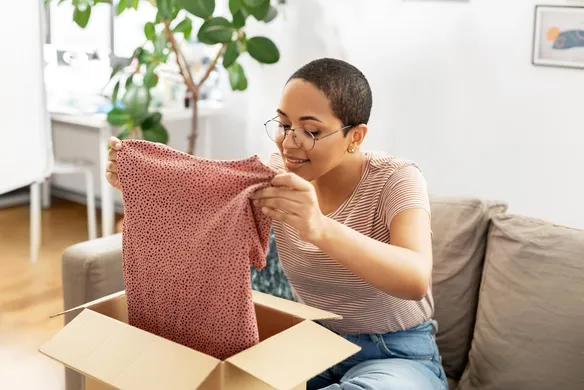Table of contents
Letting customers safely try on or test out merchandise is a growing challenge for retailers. Because of COVID-19 and the rise of ecommerce, it’s a much bigger commitment for shoppers to leave their homes to go to a brick-and-mortar store and for retailers to allow customers to touch and interact with items.
That’s why implementing some kind of try-before-you-buy experience helps retailers meet safety guidelines while ensuring a positive experience for shoppers.
Here are a few of the ways retailers are helping customers make informed shopping decisions, but with less emphasis on physical interactions and fitting rooms.
Augmented reality try-on
Smartphone cameras and webcams are making augmented reality (AR) shopping possible. AR tools, which overlay digital images over real ones, help customers see how various items like clothing, shoes, cosmetics, jewellery, or eyeglasses would look on them.
Shoppers can also use this technology to preview how decor items would look in their homes. These apps help customers virtually try out items in various colours or combinations before making a purchase.
AR tryout tools have seen rising use for years in the US, with Home Depot’s popular app offering AR functionality since at least 2013. The app shows users true-to-life 3D visuals of what Home Depot products would look like in a given space. [Ikea] (https://www.architectmagazine.com/technology/ikea-launches-augmented-reality-application_o) is another great example. The pandemic, however, has accelerated the value of augmented reality for shoppers stuck at home.
US jewellery brand Kendra Scott, for example, debuted an AR app in May 2020 as it adapted to temporarily closing 108 of its physical stores. The app lets users “try on” earrings via smartphone camera. Meanwhile, closer to home Fantastic Furniture is an Australian company offering AR for home decor and furniture. These are just a few examples.
Virtual reality design planning
Virtual reality (VR) takes the idea of AR shopping a step further, allowing customers to use VR headsets to enter entirely virtual physical environments for various shopping and tryout purposes. According to a GetApp survey in 2020, 12 percent of Australian consumers are using virtual reality (VR) technology, with 40 percent saying they would be willing to try.
Myer was actually the first department store in Australia to introduce virtual reality shopping, and they did this back in 2016. Working in association with eBay, Myer offered more than 12,500 products that could be browsed, selected and added to a cart using eBay Sight Search. Since then, and of course particularly since COVID-19 hit, more companies have taken this on board and people can shop for a range of products.
Ship-and-return programs
While augmented reality and virtual reality give customers a way to connect with products digitally, other tryout programs put goods right in the customer’s home. Subscription box companies like wardrobe service GlamCorner, for example, allow members to choose clothing from thousands of styles and hundreds of designers to receive a set number of items every month. If you don’t like an item, return the box and get a new one sent out.
GlamCorner also tracks customer preferences, helping them improve their item recommendations over time. Eyewear company Frankie Dean, meanwhile, sends customers five pairs of glasses to try on at home, expecting them to send back all but one.
Both companies also offer free returns and use prepaid labels to simplify the return process for customers. Small businesses looking to incorporate a ship-and-return program into their offerings should think carefully about how the costs of free returns would affect their margins, and should spend time crafting clear return policies and programs (that include sanitising all returned items upon delivery).
In-depth product information
Retailers can minimise returns and help drive new purchases by providing a wealth of up-front resources to help inform customers’ decisions. Creating high-quality photos and product videos help customers see items in context and know what the exact colours and finishes on an item look like.
Sample-based models are another try-before-you-buy approach, where customers can get more comfortable with products prior to purchase. Birchbox, for example, charges customers US$15 or less per month for a customised monthly box with several beauty or grooming samples inside. Customers get to keep all the samples and can buy full-size versions of the products on the Birchbox online store. They ship to Australia, or you can shop around and find local companies that offer similar. GoodnessMe box is a popular option for healthy food options, and the company offers a beauty products box as well.
A small business might try a similar take on this approach by selling curated boxes of small goods selected from a collection of items, and offering them for a set price with more information (and a discount) on the full collection.
Reimagined store experiences
[Online stores] (https://squareup.com/au/en/online-store) and social media selling are more integral to retailers’ success than ever amid the pandemic. But some customers still prefer to visit physical stores and interact with products in person.
There are two key ways retailers are reimagining their physical stores to meet those customers’ needs. One is turning the store into a showroom, in which merchandise is out for display only, with store associates retrieving items from the back to try on or purchase.
The other is appointment-based shopping. [MAC Australia] (https://www.maccosmetics.com.au/makeup-services), a make-up store, is one company that provides appointment-based shopping experiences, as does Seiko Australia, among others. These are conducted both in-store and online.
The importance of inventory management
Try-before-you-buy business models require the right digital toolset. Without well-synced inventory across both in-store and online channels, retailers can’t stay up to date on what’s out for try-on or available in-store for purchase. This can lead to customer confusion and the potential for lost sales.
With the right inventory management system, retailers can experiment with innovative try-before-you-buy approaches that help customers get comfortable with products without spending extensive time in-store.
![]()











